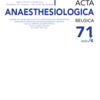Enhancement of muscle relaxant effect of rocuronium by intraseptal injection of a solution containing lidocaïne and epinephrine : a case report
Rocuronium, Lidocaine, Epinephrine, Neuromuscular blocking agents, Postoperative residual curarization
Published online: Mar 30 2020
Abstract
Introduction : Various drugs and physiologic disturbances affect the action of neuromuscular blocking agents. If some are ignored by the anesthesiologist, e.g. in the absence of monitoring of neuromuscular function, the patient may be at risk of potentially severe consequences related to postoperative residual curarization.
Case presentation : A 67-year-old female patient underwent septoplasty under general anesthesia with basic monitoring (three-lead electrocardiogram, non-invasive blood pressure, end-tidal partial pressure of carbon dioxide and SpO2) and a monitoring of neuromuscular function using acceleromyography of the adductor pollicis. General anesthesia was induced with propofol and sufentanil. After neuromuscular monitoring calibration, a single dose of rocuronium was given. Thereafter the trachea was intubated and anesthesia was maintained with sevoflurane. One hundred and two minutes after the administration of rocuronium, a 1% lidocaine solution containing 5µg/mL epinephrine was injected under the mucosa of the nasal septum immediately before the incision. Two minutes after this injection, the train of four ratio was significantly reduced. It took about 13 minutes to recover to the value recorded before the submucosal injection.
Conclusion : Epinephrine increases the degree of muscle relaxation achieved by rocuronium, even when neuro-muscular function is recovering. Monitoring is the only mean to rule out a risk of postoperative residual curarization, given the numerous medications and factors interfering with the action of neuromuscular blocking agents.
